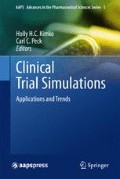Abstract
PD0332334 (PD334) is a novel beta amino acid analog of pregabalin (Pgb). Pregabalin has been previously studied in six clinical studies of general anxiety disorder (GAD). Because these compounds have similar pharmacology, certain features of their dose response relationships could be similar. Thus, data from the pregabalin GAD program was used to provide information about the safety (incidence of somnolence) and efficacy (reduction in Hamilton Anxiety Rating score) dose–response relationships for PD334 in GAD. This chapter illustrates the use of prior pregabalin data from other large-scale clinical studies to select the PD334 dose range to study in Phase 3, and the implementation of models based on assumptions of common PD334/pregabalin dose–response features that resulted from consideration of the comparative pharmacology. External validation of the PD334 dose–response model with Phase 3 data is demonstrated.
Access this chapter
Tax calculation will be finalised at checkout
Purchases are for personal use only
References
Dooley JD, Taylor CP, Donevan S, Feltner D (2007) Ca2+ channel α2δ ligands: novel modulators of neurotransmission. Trends Pharmacol Sci 28:75–82
Feltner DE, Crockatt JG, Dubovsky SJ, Cohn CK, Shrivastava RK, Targum SD et al (2003) A randomized, double blind, placebo-controlled, fixed-dose, multicenter study of pregabalin in patients with generalized anxiety disorder. J Clin Psychopharmacol 23:240–249
Lalonde RL, Kowalski KG, Hutmacher MM, Ewy W, Nichols DJ, Milligan PA, Corrigan BW, Lockwood PA, Marshall SA, Benincosa LJ, Tensfeldt TG, Parivar K, Aantea M, Glue P, Koide H, Miller R (2007) Model-based drug development. Clin Pharm Ther 82:21–32
Mandema JW, Wang W (2003) Use of modeling and simulation to optimize dose-finding strategies. In: Kimko HC, Duffull SB (eds) Simulation for designing clinical trials, vol 127, Drugs and the pharmaceutical sciences series. Marcel Dekker, New York, pp 289–312
Mandema JW, Cox E, Alderman J (2005a) Therapeutic benefit of eletriptan compared to sumatriptan for the acute relief of migraine pain – results of a model-based meta-analysis that accounts for encapsulation. Cephalalgia 25:715–725
Mandema JW, Hermann D, Wang W, Sheiner T, Milad M, Bakker-Arkema R, Hartman D (2005b) Model-based development of Gemcabene, a new lipid-altering agent. AAPS J 7(3):E513–E522. Article 52 http://www.aapsj.org.Accessed Aug 2009
Montgomery SA, Tobias K, Zornberg GL, Kasper S, Pande AC (2006) Efficacy and safety of pregabalin in the treatment of generalized anxiety disorder: a 6-week, multicenter, randomized, double blind, placebo-controlled comparison of pregabalin and venlafaxine. J Clin Psychiatry 67:771–782
Pande AC, Crockatt JC, Feltner DE, Janney CA, Smith WT, Weisler R et al (2003) Pregabalin in generalized anxiety disorder: a placebo controlled trial. Am J Psychiatry 160:533–540
Pohl RB, Feltner DE, Fieve RR, Pande AC (2005) Efficacy of pregabalin in the treatment of generalized anxiety disorder: double blind, placebo-controlled comparison of BID versus TID dosing. J Clin Psychopharm 25:151–158
Rickels K, Rynn MA (2001) What is generalized anxiety disorder. J Clin Psychiatry 62(suppl 11):4–12
Rickels K, Pollack MH, Feltner DE, Lydiard RB, Zimbroff DL, Bielski RJ et al (2005) Pregabalin for treatment of generalized anxiety disorder: a 4-week, multicenter, double blind, placebo-controlled trial of pregabalin and alprazolam. Arch Gen Psychiatry 62:1022–1030
Vogel JR, Beer B, Clody DE (1971) A simple and reliable conflict procedure for testing antianxiety agents. Psychopharmacologia 21:1–7
Weisberg RB (2009) Overview of generalized anxiety disorder: epidemiology, presentation and course. J Clin Psychiatry 70(suppl 2):4–9
Wittchen H-U, Hoyer J (2001) Generalized anxiety disorder: nature and course. J Clin Psychiatry 62(suppl 11):15–19
Author information
Authors and Affiliations
Corresponding author
Editor information
Editors and Affiliations
Rights and permissions
Copyright information
© 2011 Springer Science+Business Media, LLC
About this chapter
Cite this chapter
Lockwood, P.A., Mandema, J.W. (2011). Model Based Development of an Agent for the Treatment of Generalized Anxiety Disorder. In: Kimko, H., Peck, C. (eds) Clinical Trial Simulations. AAPS Advances in the Pharmaceutical Sciences Series, vol 1. Springer, New York, NY. https://doi.org/10.1007/978-1-4419-7415-0_15
Download citation
DOI: https://doi.org/10.1007/978-1-4419-7415-0_15
Published:
Publisher Name: Springer, New York, NY
Print ISBN: 978-1-4419-7414-3
Online ISBN: 978-1-4419-7415-0
eBook Packages: Biomedical and Life SciencesBiomedical and Life Sciences (R0)


